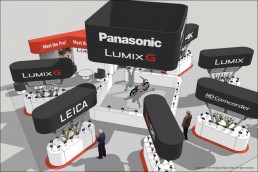8 ways designers can protect their creative credentials
If you are unsure what creative credentials are, then quite simply, it is essentially the portfolio of original work of which you or your company owns the copyright. In essence, it is a promise of the type of work your client might expect from you, should they secure your services.
Businesses must showcase their design projects to attract new customers, and this means putting it on display online. However, by publishing work online, it makes you more vulnerable to thievery and the possibility of others using it for their gain. Your concepts, creativity, and plans as a designer or design agency are a valuable commodity, so any original work that is owned by you or your company deserves proper attribution, not to mention that stealing it is a direct violation of copyright law.
As a design company, it always amazes us as we trawl through websites and social media sites, just how many businesses have the audacity to claim our design credentials as their own. How can you stop this deceit, without instigating copyright proceedings? The following approaches might be useful;
1. Have an active presence online
Ensure your work is published as widely as possible online to discourage others claiming your design work as their own. Having a strong presence online should make those involved in the deceit think twice about including your work in their portfolio, or putting it on social media as their original work. If you discover images or designs, to which you own the copyright, being used by another company, we suggest a quick email to the infringer to suggest either proper attribution or the take-down of the work.
2. State your copyrights explicitly
Ensure you have explicit copyright descriptions detailed on all designs and pitch proposals sent for costing to third party suppliers for production. An efficient way to do this is to include the © symbol, your name, and the year you created the work. Ensure every project has a page explaining how copyright protects your work, as you have no control where it will end up once it leaves your computer. We include details in every proposal concerning copyrights, design rights, confidentiality, and privacy. By stating that you retain ownership of all material supplied as part of the pitch, then you have some legal recourse, should you wish to pursue copyright infringement.
3. What about unpublished work?
When work is in the concept stage of a client brief or pitch, unscrupulous employees can send your designs to competitors or other companies to copy to avoid having to pay any design fees. Be very selective about who you work with and if at all possible, avoid the temptation to enter into “free” pitch arrangements. If you do decide to respond to “free” pitch request, it is worthwhile trying to find out prior to submitting any creative concepts
- Whether the pitch is procurement -led i.e. purely cost-driven, or marketing led i.e. driven by creativity?
- How many other companies you will be pitching against?
- Whether any company pitching already has an inside track?
- And finally whether your submissions and time will be paid for?
“Unlike in some business sectors such as advertising or architecture, design solutions cannot be treated as a ‘loss leader’ against future income, as the ‘bait’ to catch the ‘fish’. They are the fish itself” – www.preddy.co.uk
4. Register your design work
It is important to register your design work, especially if you intend to publish it on online. In the UK, the British Copyright Council and the can assist you in doing so, and in the US, it is the United States Patent and Trademarks Office. Industry bodies like AIGA, the UK Design Council, and British Design Innovation, provide templates, take-down letter, legal advice and other resources for those who believe infringement of their creative rights has occurred.
5. Be ambitious about your work
Don’t be mild-mannered and modest about your designs; celebrate your portfolio of successful projects. There are a variety of sites that will broadcast your creative work including Behance, Dribbble, Coroflot, Pinterest, The Creative Finder and Carbonmade. Put all your work online, and although some may be tempted to steal your ideas, feel secure in the knowledge that the copiers can’t fake creativity forever. The good news is that the wider creative community can be incredibly supportive in ‘calling-out’ the suspected infringers, so make sure to keep a blog and highlight any issues of infringement where you feel you have a watertight case.
6. Keeping track of your work
It can be a real challenge in identifying and tracking instances where another has used your creative work, but fortunately, there are now services that check for image infringement, such as TinEye and Google’s reverse image search. Both these services can be used to trawl the web for instances of work being copied and passed off as someone else’s. Creative Barcode is a website that can track your work for you and enables you to authenticate, disclose safely, and protect your business, creative & innovation concepts worldwide. Endorsed by World Intellectual Property Organisation (WIPO), users can register and protect their intellectual property by creating IP Tags that contain the creator and owners’ details to ensure correct attribution, on a global basis. IP Tags are exclusive to your propositions and concepts. The tags are applied to all items disclosed including concept iterations and time-stamped, and verify your continuous innovation journey.
7. Control the project communications
Copyright infringement is not the only problem that arises with creative work. Sometimes partners within the supply chain can explicitly state or suggest that they were responsible for the entire project, when, in fact, their involvement may have been limited. Most agencies we’ve worked with are incredibly honest. However, we had the experience of working alongside an agency some years ago who were supplying our client with the promotional staff and metrics for a roadshow we’d designed. The agency claimed in press releases to not only to provide the promotional staff for the roadshow but also the design and production of the entire national event. When our client found out, they were not impressed and as a result the company in question has never worked with our client again.
We would suggest that if there is more than one company involved in your client’s project, to encourage your client to agree up front with all stakeholders what everyone can say about their involvement in the project. Alternatively, with approval, put out a press release explaining who did what, to encourage transparency, not protectionism.
8. Take the long view
For a safer trading environment, we would encourage working directly with the end client, or to start aligning your business with agencies as trusted partners. Avoid white-labelling work to ensure that you protect your creative credentials. Resist short-term thinking and do not trade your creativity for your dependence on your quarterly earnings. Communicate the compromises and costs involved in having too many suppliers in the supply chain and encourage businesses to see the value in going directly to the specialists, rather than relying too heavily on full-service agencies to deliver everything. In the long run, hiding your creative credentials will eventually impact on your ability for growth.
After all, “Lasting influence is better than a burst of fame.”
I’d love to hear how other designers or design agencies protect their creative credentials and design work. What measures, if any, do you take when you realise your creative work has been used by an individual or another company and promoted as their own? Please post your comments below.
Blog post written by
Amanda Bates – Marketing Director – SHAPES

